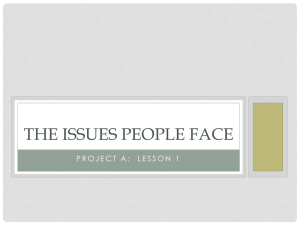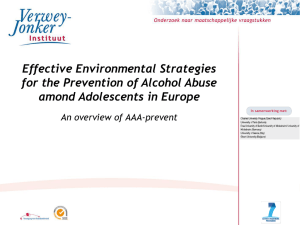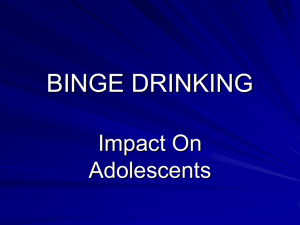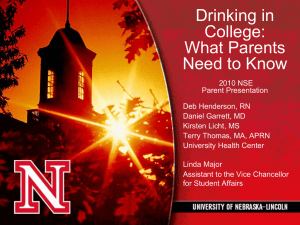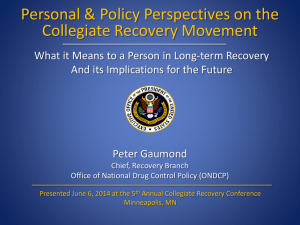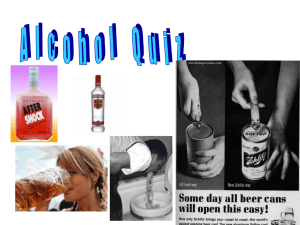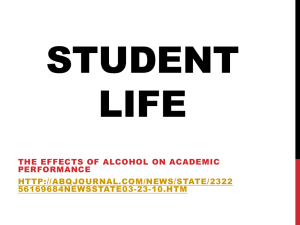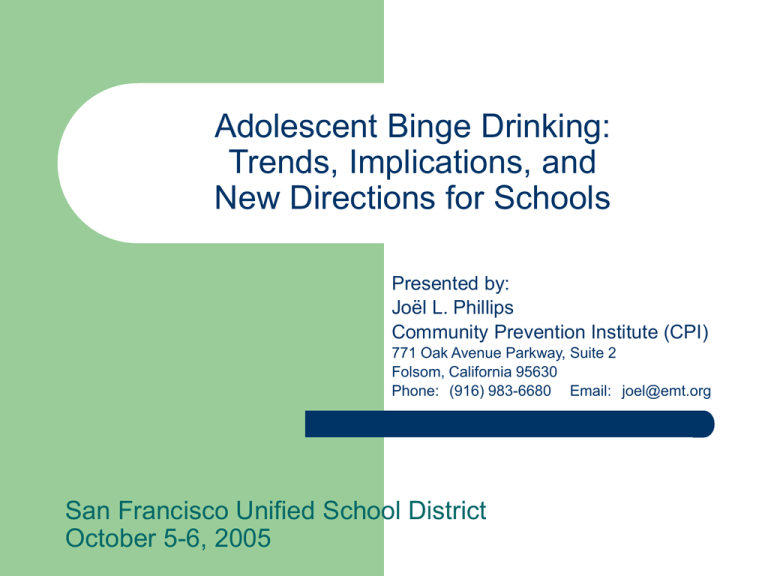
Adolescent Binge Drinking:
Trends, Implications, and
New Directions for Schools
Presented by:
Joël L. Phillips
Community Prevention Institute (CPI)
771 Oak Avenue Parkway, Suite 2
Folsom, California 95630
Phone: (916) 983-6680 Email: joel@emt.org
San Francisco Unified School District
October 5-6, 2005
Issues
2
What constitutes excessive alcohol consumption?
Is there a problem with excessive alcohol use among
California adolescents?
If so, to what extent?
Are there disparities to address?
What are the consequences of excessive alcohol
consumption?
What can we do?
What is Excessive Alcohol
Consumption (Binge Drinking)?
General
Binge (high risk) drinking is the consumption of alcohol to the
extent that harmful consequences – health, academic, legal
and others – may be expected.
Specific (Recent NIAAA definition)
A “binge” is a pattern of drinking alcohol that brings the blood
alcohol level concentration (BAC) to 0.08 or above. For the
typical adult, this pattern corresponds to consuming 5 or more
drinks (male), or 4 or more drinks (female), in about 2 hours.
A “drink” refers to half an ounce of alcohol (e.g., one 12-oz.
beer, one 5 oz. glass of wine, or one 1.5 oz. shot of distilled
spirits.)
3
Excessive Alcohol & High-Risk Drug Users
Grade 11
60
50
40
30
20
10
0
1991-92 1993-94 1995-96 1997-98 1999-00 2001-02 2002-03
Excessive Alcohol Users (EAU)
4
High-Risk Drug Users (HRU)
Dimensions of the Problem
Table 1. High Risk Drug Use & Excessive Alcohol Use
91-92*
(%)
93-94
95-96
97-98
99-00
01-02
02-03
Grade 9
Excessive Alcohol Users (EAU)
18.5
21.0
23.3
19.4
16.4
17.1
14.3
High-Risk Drug Users (HRU) a
11.4
21.2
20.2
20.3
11.0
10.4
9.3
Total EAU or HRU
22.0
29.1
28.5
29.5
19.4
20.0
17.4
Excessive Alcohol Users (EAU)
27.5
29.2
31.3
30.8
33.9
32.4
29.9
High-Risk Drug Users (HRU) a,
17.6
26.6
26.8
26.9
20.7
21.3
17.3
Total EAU or HRU
32.5
37.8
38.4
38.6
37.6
35.7
33.6
Grade 11
a
Refers to drug use in the past six months only. *Passive parent consent required for participation; starting in 1995, active (written)
consent was required.
5
Trend Data Results
The trend data in Table 1 supports several conclusions:
1. High rate use of alcohol or drugs by California students increases
significantly in the middle and high school years.
2. Despite the emphasis on alcohol and drug prevention in schools, the
percentage of students who report high use rates for alcohol or other
drugs has been relatively constant over the last decade; 2002-2003
EAU and HRU rates are nearly the same as the 1991-1992 rates.
3. Excessive alcohol use is more prevalent than high risk drug use.
4. A substantial percentage of California secondary school students
report that they are high rate users.
6
Why Focus on Binge Drinking?
16 Sobering Facts.
Young People and Early Drinking Consequences…
Boys are more likely than girls to begin drinking before
age 13.* The earlier underage drinking begins, the greater
the risk for developing a serious alcohol-related problem,
including addiction.
Among 12-17 year olds who are current
drinkers, 31% have exhibited extreme levels
of psychological distress and 39% have
exhibited serious behavioral problems.**
7
*Centers for Disease Control and Prevention. June 2000. Youth Risk Behavior
Surveillance – United States, 1999. Morbidity and Mortality Weekly Report 49(SS05):1-96
** Substance Abuse and Mental Health Services Administration (SAMHSA). 1999. The Relationship
Between Mental Health and Substance Abuse Among Adolescents. Rockville, MD: SAMHSA.
Why Focus on Binge Drinking?
16 Sobering Facts.
Young People and Early Drinking Consequences…cont.
Among 8th grade girls who drink heavily, 37% report
attempting suicide, compared to 11% who do not drink.*
40% of children who start drinking before the age of 15 will
become alcoholics at some point in their lives. Delaying the use
of alcohol until the legal age helps avoid many of the associated
problems. If the onset of drinking is delayed by 5 years, a child’s
risk of serious alcohol problems is cut in half**
8
*Windle M.A. 1992. Alcohol use, suicidal behavior, and risky activities among adolescents.
Journal of Research on Adolescence 2(4).
**Grant, B.F. 1998. National Institute of Alcohol Abuse and Alcoholism on The Relationship Between Age
at Onset of Alcohol Use and DSM-IV Alcohol Dependence. ,Results from the National Longitudinal Alcohol
Epidemiologic Survey. Alcohol Health and Research World 22(2).
Why Focus on Binge Drinking?
16 Sobering Facts.
Young People, Drinking and Sexuality.
Alcohol use in adolescents is a strong predictor of
both sexual activity and unprotected sex. Teenage
girls who drink are more likely to have sex and have
it without a condom than girls who do not drink alcohol.*
Half of the girls who have sexual intercourse by the
age of 16 are intoxicated at the time and half later
regret their action.**
9
*Centers for Disease Control and Prevention. 1999. Youth Risk Behavior Surveillance System Summary.
Washington DC: U.S. Department of Health and Human Services, Public Health Service.
**Sachs, H.C. MD. April 2000. Teens trying drugs and alcohol. Contemporary Pediatrics 17(4):45.
Why Focus on Binge Drinking?
16 Sobering Facts.
Young People and Unwanted Sexual Encounters.
Researchers estimate that alcohol use is implicated in
one to two thirds of sexual assault and “date rape” cases
among teens and college students.*
A survey of high school students found that 18% of
females and 39% of males say it is acceptable for a
boy to force sex if the girl is stoned or drunk.**
10
*Office of the Inspector General, U.S. Department of Health and Human Services (HHS). April 1992.
Youth and Alcohol: Dangerous and Deadly Consequences. Washington DC: HHS.
**Office of the Inspector General, U.S. Department of Health and Human Services. Last accessed
On September 21, 1999. Dangerous and Deadly Consequences. www.ncadd.org/youthalc.html.
Why Focus on Binge Drinking?
16 Sobering Facts.
Young People, Drinking and School.
A survey of students at 119 colleges found that 44% of students
are binge drinkers (have five or more drinks per occasion).*
As many as 360,000 of the Nation’s 12 million undergraduates
will eventually die from alcohol-related problems, many of which
began in college. This is more than the number who will get
M.A.s and Ph.D.s combined.**
Alcohol on college campuses is a factor in 40% of all academic
problems and 28% of all dropouts.***
11
*Weschler, H; Lee, J; Kuo, M.; and Lee, H. 2000. College Binge Drinking in the 1990s: A continuing Problem.
Results of the Harvard School of Public Health 1999 College Alcohol Study. Cambridge, MA: Harvard School of Public
Health.
**Eigen, L. February 1991. Alcohol Practices, Policies and Potentials of American Colleges and Universities. An OSAP
White Paper, Rockville, MD: Office for Substance Abuse Prevention.
***Anderson, D. 1994. Breaking the Tradition on College Campuses: Reducing Drug and Alcohol Misuse . Fairfax, VA:
George Mason University.
Why Focus on Binge Drinking?
16 Sobering Facts.
Drinking and our Culture.
In recent television programs, 9 out of 10 drinkers are
portrayed as either experiencing no effects at all or
only positive personal and social outcomes from their
alcohol consumption.*
12
*Gerbner, G. October 1996. Television Violence and Alcohol Use
Declines, but Smoking Still Shown as Risk-Free. Center for Substance
Abuse Prevention News Release.
Why Focus on Binge Drinking?
16 Sobering Facts.
Young People, Drinking and Driving.
33% of 9th graders report having ridden in a car driven by
someone who has been drinking alcohol.*
For every 100,000 licensed drivers, young drinking
drivers are involved in fatal crashes at approximately
twice the rate of drivers age 21 and older.**
Even small amounts of alcohol are dangerous for young, Inexperienced drivers.
In 1998, more 18 year olds died in low blood alcohol concentration
(between .01 and .09) alcohol-related crashes than individuals of any other age.***
About 3 in every 10 Americans will be involved
in an alcohol-related crash at some time in their lives.****
13
*Centers for Disease Control and Prevention. 1997. Youth Risk Behavior Surveillance – United States
Morbidity and Mortality Weekly Report 47(SS-3):1-89.
**National Highway Traffic Safety Administration (NHTSA). 1999. 1998 Youth Fatal Crash and Alcohol Facts. Washington DC:
U.S. Department of Transportation.
***Ibid
****NHTSA. 1999. Traffic Safety Facts 1998 – Alcohol. (DOT HS 808 950). Washington DC: U.S. Department of Transportation.
Binge Drinking
Table 2. Frequency Consumed Five or More Drinks in a Row, Past 30 Days
Grade 7
Never
Grade 9
Grade 11
19992000
20012002
20032004
19992000
20012002
20032004
19992000
20012002
20032004
(%)
(%)
(%)
(%)
(%)
(%)
(%)
(%)
(%)
94.2
97.2
96.3
86.7
86.6
88.5
73.8
73.7
76.7
1+ days
5.8
2.8
3.7
13.3
13.4
11.5
26.2
26.3
23.3
3+ days
1.7
1.0
1.3
6.1
7.2
5.1
14.2
14.0
12.2
10+ days
0.9
0.6
0.6
2.5
2.4
1.9
4.5
5.1
4.2
• By the 11th grade, approximately one fourth of the student sample reported binge
drinking at least once in the last 30 days.
14
• Approximately 12 percent of 11th graders binged 3 or more days in the past month.
2003 Youth Risk Behavior Survey
San Francisco High School Survey
Percentage of students who had at least one drink of alcohol on one or more of the past 30 days
100
80
60
40
24.5
25.6
23.5
20
15
18.3
15.8
9th
10th
31.3
31.4
11th
12th
0
Total
Males
Females
2003 Youth Risk Behavior Survey
San Francisco High School Survey
Percentage of students who had five or more drinks of alcohol in a row, that is, within a couple of
hours, on one or more of the past 30 days
100
80
60
40
20
16
10.2
11.6
8.9
6.8
5.7
Total
Males
Females
9th
10th
13.0
14.2
11th
12th
0
2003 Youth Risk Behavior Survey
San Francisco High School Survey
Percentage of students who had at least one drink of alcohol on school property on one or more of
the past 30 days
100
80
60
40
20
17
0
5.4
6.1
4.9
5.5
3.9
Total
Males
Females
9th
10th
7.2
4.5
11th
12th
Binge Drinkers and Problem Behavior
Table 3. Other Alcohol-use Correlates of Binge Drinking, 11th Graders, 2003 CSS
Total
Sample
Binge Drank,
Past 30
Days
Non-binge
Drinker, 30
Days
No Alcohol,
30 Days
7.0
21.2
4.1
2.2
Was drunk 3 or more times
19.6
56.8
20.9
6.2
Drink/drive episode, 3 or more
12.5
32.4
14.6
5.8
Fight between groups, year
17.7
29.5
20.4
12.7
Used weapon to threaten, year
8.6
17.1
11.3
5.9
Been in a gang, ever
9.2
15.8
10.4
7.5
Relationship violence, year
8.2
14.9
7.9
6.4
Likes to get really drunk
18
• Binge drinkers are much more likely to put themselves and others in harm’s way through being
intoxicated and through drinking and driving.
• Binge drinkers are more likely to be involved in gangs and potential violence than students
who do not binge.
• Binge drinkers are more likely to be involved in relationship violence, an issue of particular
relevance to Student Assistance Programs (SAPs).
Binge Drinkers and School Behavior
Table 4: Binge Drinking and School Behaviors
Non-binge
Drinker, 30
Days
Total Sample
Binge Drank, Past
30 Days
No Alcohol,
30 Days
Used alcohol at school, past 30 days
8.0
23.6
5.9
2.8
Drunk/high at school, 3 or more times
12.1
30.4
11.5
5.7
Physical fight at school
20.5
32.2
30.6
14.7
Taken a weapon to school
13.0
23.1
13.6
9.2
Damaged school property
17.8
31.2
20.1
13.2
Skip school/cut class (ever)
60.3
82.9
54.2
50.9
Skip school/cut class (“few times” or
more)
39.3
60.7
33.0
29.8
Low school connectedness
21.0
26.3
19.4
19.3
School-related Alcohol Use
School Violence (Year)
School Behavior
19
Much more likely to use substances at or before school, and to be under the influence of substances at school;
Somewhat more likely to engage in violent or destructive behavior at school;
Much more likely to skip school or cut class; and
Tend to have lower connectedness to school.
Other Behaviors that Go Hand-in-Hand with
Excessive Alcohol Consumption
Youth with serious alcohol problems (approximately 9% of CA males and females
ages16 to 17):
20
11 times more likely to have serious problems with other drugs
10 times more likely to drink and drive
4 times more likely to be arrested
2 times more likely to have a C average or lower and are likely to miss twice as much
school
2 times more likely to smoke
1.5 times more likely to require hospital emergency care
5 times more likely to commit suicide
4 times more likely to get into a serious fight
3.5 more times more likely to carry a weapon
3 times more likely to have a conduct disorder
3 times more likely to be hospitalized with a mental health problem
2 times more likely to get into an accident, injure another person or themselves
Almost twice as likely to have multiple sex partners
(Source: George Washington University Medical Center)
Other Consequences
21
Binge drinking in high school, especially
among males, is strongly predictive of binge
drinking in college. (NIAAA)
Young persons who begin drinking before
age 13 are four times as likely to develop
alcohol dependence and twice as likely to
develop alcohol abuse as those who begin
drinking at age 21. (National Longitudinal
Alcohol Epidemiologic Survey)
Gender Discrepancies
22
Underage youth saw more alcohol advertising than
adults, on a per capita basis, in magazines in 2002.
Girls were even more overexposed to this
advertising than boys (Archives of Pediatrics &
Adolescent Medicine, 2004).
In 2002, MTF found that eighth- and 10th-grade girls
surpassed boys for the first time as current drinkers.
In 2003, CDC found that more girls consume alcohol
than boys and they binge drink more often.
An AMA poll found that the average age of a girl’s
first drink is now 13.
Why Worry About Girls?
23
Girls tend to feel the impairing effects of alcohol
much faster than males.
Effects include liver, brain and heart damage as well
as gender-specific complications such as increased
chances of breast cancer, osteoporosis, menstrual
disorders and pregnancy.
Relationship violence.
Sexual assault and date rape.
Unplanned and unprotected sex.
Fetal alcohol syndrome.
Adolescent Brain Development
New information constantly emerging.
Ethical considerations prevent use of adolescents
–
But brain scans and animal studies are revealing
Some facts
Brain is still maturing in adolescents
–
–
24
Can account for “poor decisions” BUT
Place teens for elevated risks to the effects of drugs and
alcohol.
Adolescent Brain Changes
25
Prefrontal Cortex (PFC) – helps process high
complex information – “seat of sobering second
thought” (judgment) – not fully developed until mid
20’s.
Amygdala – Structure responsible for integrating
how to emotionally react to pleasurable and aversive
experiences. It’s developing in adolescence.
Result: Youth tend to react to situations with “hot”
emotions rather than more controlled “cool”
emotions. Tends to dominate the PFC.
Introduce Alcohol Into The Mix
Immature PFC
“Hot” button of the amygdala
Result: Poor decisions.
But there’s more….
26
Alcohol Hijacks the Brain’s Reward
Circuitry
27
Continued use of alcohol reduces the brain’s
dopamine production.
Because dopamine is part of the reward
system, the brain is “fooled” that alcohol has
survival value for the organism.
The reward system responds with “drug
seeking behaviors.”
Craving occurs and, eventually, dependence.
Adolescents with a History of
Extensive Alcohol Use
28
Decrease in hippocampus by 50%
(hippocampus converts information to
memory).
Decrease in brain activity during memory
tasks.
Increase in brain activation when shown
alcohol images (trigger for relapse).
Adolescents Are More Susceptible to
Alcohol Than Adults
29
Reduced sensitivity to intoxication
Increased sensitivity to social disinhibitions
Greater adverse effects to cognitive
functioning
Medicates “excitability”
Long-Term, Heavy Use of Alcohol
30
Significant shrinking of the brain
50-70% show cognitive impairment
Effects remain even after detoxification and
abstinence
Alcohol dementia is the 2nd leading cause of
adult dementia
Findings
Brain undergoes tremendous amount of
development during adolescents
Alcohol affects teens differently from adults
–
–
31
Bigger impairments in learning/memory
Less sensitivity to effects
Repeated alcohol exposure might alter path of teen
brain development
Decisions youth make can influence brain
development
We may not be able to make up for decisions made
as teens – brain is more hardwired in 20’s.
Unhealthy Choices = Unhealthy Brain
What Can We Do?
32
1.
Recognize there is a serious problem with binge drinking in our
schools and communities.
2.
Increase awareness/knowledge of consequences of underage
binge drinking by sharing information with health care providers
and educators, teachers, administrators, business leaders, public
officials, community advocates, parents, and students. Utilize
existing infrastructure of local coalitions if possible.
3.
Examine local prevention/intervention services for alignment with
best practice strategies.
4.
Modify existing services as needed. CPI can provide no-cost
technical assistance and training.
Understand…
Need for best data on underage use of AOD
Need for a simple process/procedure to
identify this group of students
Need for Intervention services
–
33
SAP’s
Need to get community/parents involved
Role of Parents
34
Reports on a study that concludes parents strongly
influence their children’s drinking behavior.
Teens were twice as likely to binge drink and use
alcohol within a 30-day period if their parents or
friends’ parents provided alcohol at their homes for a
party.
Parents who set strict consequences for breaking
the house rules regarding drinking can help prevent
underage drinking.
Student Assistance Programs
35
A recognized, school-based approach to providing
focused services to students needing interventions
for substance abuse or other problems.
Few studies, but with promising results.
SAPs are uniquely tailored to local needs.
Selective participation.
Collaboration.
Screening and assessment.
Multiple services.
Potential SAP Services
36
Academic support
Counseling services
After-school activities
Substance use education
Violence prevention and conflict mediation
Peer support and mentoring programs
Career services
Complementary Model Programming:
Project Toward No Drug Abuse
37
Recommended for indicated and selective high school youth.
Originally developed to work with youth in alternative high
schools with higher risk youth, but has since been adopted by
many traditional high schools.
Targets ATOD by encouraging youth to participate in lower-risk
activities, to appreciate the risks of drugs on the body, and to
develop positive decision-making skills.
40- to 50-minute interactive curriculum designed to be
presented in 12 lessons.
Good fit for a pullout group format.
Complementary Model Programming:
Too Good For Drugs
38
Recommended for selective middle and high school youth.
Middle school curriculum is grade-specific; high school is not.
Designed to reduce the intention to use ATOD during the middle and
high school years.
Relies on small group activities, role play and group discussions
regarding appropriate attitudes toward ATOD use, knowledge of
ATOD’s negative consequences, the benefits of a drug-free lifestyle,
and positive peer norms.
Also meets the needs of sites seeking to prevent conflict and violence
on their campuses.
Pullout structure okay as long as the same students are served
throughout the program.
10-lesson curriculum once a week for 14 lessons.
Optional home workouts for parents and infusion lessons are included
Questions?
39
www.ca-cpi.org
771 Oak Avenue Parkway, Suite 3
Folsom, CA 95630
916-983-8929-MAIN
916-983-5738-FAX
40

